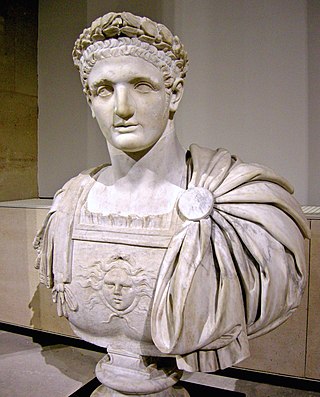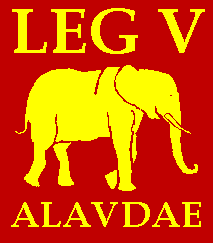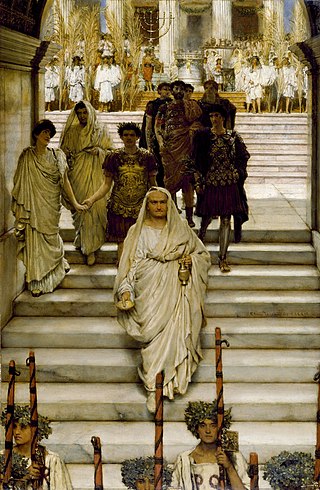History
After Teutoburg
After the disaster of the Battle of the Teutoburg Forest, the legion was sent as reinforcements to Germania Inferior, where they shared the base camp of Castra Vetera (Xanten) with V Alaudae. Both Legio V and Legio XXI were involved in a mutiny in AD 14. [2] In 43, they were relocated in Vindonissa , in the province of Germania Superior.
The legion occupied Vindonissa from 46 to 69 with two auxiliary cohorts, first the III Hispanorum and VI Raetorum, and later the VII Raetorum equitata and the XXVI voluntariorum civium Romanorum.
Along with the rest of the German border army, the XXI Rapax supported its commander, Vitellius, in the Year of the Four Emperors (69) and defeated Othonian forces at the First Battle of Bedriacum. [3] Vitellius was, however, defeated by Vespasian before the end of the year.
In 70, the legion was part of the army sent to deal with the Batavian rebellion and relieve the four legions imprisoned by Civilis. After that they were sent to Germania Superior, where they shared the castrum (camp) of Moguntiacum (modern day Mainz) with XIV Gemina.
In 89, the legions in Moguntiacum supported their commander, Lucius Antonius Saturninus, in his revolt against emperor Domitian. After the end of this unsuccessful insurrection, the legions were separated and XXI Rapax sent to Pannonia. [4]
Destruction
In spring of 92, several tribes (probably Marcomanni, Quadi, Jazyges) crossed the Danube and attacked Pannonia, probably destroying XXI Rapax. These tribes would be defeated from May to December 92, and chased back over the river. The Romans did not pursue the retreating tribes. [5]

Domitian was Roman emperor from 81 to 96. The son of Vespasian and the younger brother of Titus, his two predecessors on the throne, he was the last member of the Flavian dynasty. Described as "a ruthless but efficient autocrat", his authoritarian style of ruling put him at sharp odds with the Senate, whose powers he drastically curtailed.

The 90s was a decade that ran from January 1, AD 90, to December 31, AD 99.
AD 92 (XCII) was a leap year starting on Sunday of the Julian calendar. At the time, it was known as the Year of the Consulship of Augustus and Saturninus. The denomination AD 92 for this year has been used since the early medieval period, when the Anno Domini calendar era became the prevalent method in Europe for naming years.

The Praetorian Guard was an elite unit of the Imperial Roman army that served as personal bodyguards and intelligence agents for the Roman emperors.

Legio II Augusta was a legion of the Imperial Roman army that was founded during the late Roman republic. Its emblems were the Capricornus, Pegasus, and Mars. It may have taken the name "Augusta" from a victory or reorganization that occurred during the reign of Augustus.

Legio XIV Gemina was a legion of the Imperial Roman army, levied by Julius Caesar in 57 BC. The cognomen Gemina (Twinned) was added when the legion was combined with another understrength legion after the Battle of Actium. The cognomen Martia Victrix was added following their service in the Pannonian War c. AD 9 and the defeat of Boudicca in AD 61. The emblem of the legion was the Capricorn, as with many of the legions levied by Caesar.

Legio IV Macedonica, was a legion of the Imperial Roman army founded in 48 BC by Gaius Julius Caesar with Italian legionaries. The legion was disbanded in AD 70 by Emperor Vespasian. The legion symbols were a bull and a capricorn.

Legio V Alaudae, sometimes also known as Legio V Gallica, was a legion of the Roman army founded in 52 BC by the general Gaius Julius Caesar. It was levied in Transalpine Gaul to fight the armies of Vercingetorix, and was the first Roman legion to comprise non-citizens. Historians disagree whether the legion was destroyed during the Batavian rebellion in AD 70, or during the First Battle of Tapae.

Legio I Adiutrix, was a legion of the Imperial Roman army founded in AD 68, possibly by Galba when he rebelled against emperor Nero. The last record mentioning the Adiutrix is in 344, when it was stationed at Brigetio, in the Roman province of Pannonia. The emblem of the legion was a capricorn, used along with the winged horse Pegasus, on the helmets the symbol used by I Adiutrix legionaries was a dolphin.
Legio I Germanica,, was a legion of the Imperial Roman army, possibly founded in 48 BC by Julius Caesar to fight for him in the civil war against Pompey. The title germanic is a reference to its service in the Germanic Wars, rather than the place of origin of its soldiers. After the Revolt of the Batavi, the remaining men of the Germanica were added to Galba's seventh legion, which became VII Gemina. The emblem of Legio I is unknown, but it was probably Taurus, like all the other legions levied by Caesar.

The Revolt of the Batavi took place in the Roman province of Germania Inferior between AD 69 and 70. It was an uprising against the Roman Empire started by the Batavi, a small but militarily powerful Germanic tribe that inhabited Batavia, on the delta of the river Rhine. They were soon joined by the Celtic tribes from Gallia Belgica and some Germanic tribes.

The Year of the Four Emperors, AD 69, was the first civil war of the Roman Empire, during which four emperors ruled in succession: Galba, Otho, Vitellius, and Vespasian. It is considered an important interval, marking the transition from the Julio-Claudians, the first imperial dynasty, to the Flavian dynasty. The period witnessed several rebellions and claimants, with shifting allegiances and widespread turmoil in Rome and the provinces.

Legio XIII Gemina, in English the 13thTwin(s) Legion was a legion of the Imperial Roman army. It was one of Julius Caesar's key units in Gaul and in the civil war, and was the legion with which he crossed the Rubicon in January, perhaps the 10th, 49 BC. The legion appears to have still been in existence in the 5th century AD. Its symbol was the lion.

The Flavian dynasty ruled the Roman Empire between AD 69 and 96, encompassing the reigns of Vespasian (69–79), and his two sons Titus (79–81) and Domitian (81–96). The Flavians rose to power during the civil war of 69, known as the Year of the Four Emperors. After Galba and Otho died in quick succession, Vitellius became emperor in mid 69. His claim to the throne was quickly challenged by legions stationed in the eastern provinces, who declared their commander Vespasian emperor in his place. The Second Battle of Bedriacum tilted the balance decisively in favour of the Flavian forces, who entered Rome on 20 December. The following day, the Roman Senate officially declared Vespasian emperor of the Roman Empire, thus commencing the Flavian dynasty. Although the dynasty proved to be short-lived, several significant historic, economic and military events took place during their reign.
Aulus Caecina Alienus was a Roman general active during the Year of the Four Emperors.
Lucius Antonius Saturninus was a Roman senator and general during the reign of Vespasian and his sons. While governor of the province called Germania Superior, motivated by a personal grudge against Emperor Domitian, he led a rebellion known as the Revolt of Saturninus, involving the legions Legio XIV Gemina and Legio XXI Rapax, camped in Moguntiacum (Mainz).

Legio IV Flavia Felix, was a legion of the Imperial Roman army founded in AD 70 by the emperor Vespasian from the cadre of the disbanded Legio IV Macedonica. The legion was active in Moesia Superior in the first half of the 5th century. The legion symbol was a lion.

Legio XI Claudia was a legion of the Imperial Roman army. The legion was levied by Julius Caesar for his campaign against the Nervii. XI Claudia dates back to the two legions recruited by Julius Caesar to invade Gallia in 58 BC, and it existed at least until the early 5th century, guarding lower Danube in Durostorum.
Cornelius Fuscus was a Roman general who fought campaigns under the Emperors of the Flavian dynasty. He first distinguished himself as one of Vespasian's most ardent supporters during the civil war of 69 AD, known as the Year of the Four Emperors. Vespasian's son Domitian employed Fuscus as prefect of the Praetorian Guard, a post he held from 81 until his death.
Fabius Valens of Anagnia was a Roman commander favoured by Nero. Valens was an undisciplined character but not without talent; he tried to portray himself as witty by behaving frivolously.










